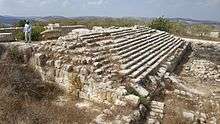Augusteum
An Augusteum (plural Augustea) was originally a site of imperial cult in ancient Roman religion, named after the imperial title of Augustus. It was known as a Sebasteion in the Greek East of the Roman Empire. Examples have been excavated in Sebaste/Samaria, Constantinople, Aphrodisias, Antioch, Cartagena and (most famously) Ankara (Monumentum Ancyranum).
Since the 18th century, the term has also been used for certain academic and cultural buildings, such as the Augustea in Leipzig, Oldenburg and Wittenberg.
See also
- Mausoleum of Augustus, Rome
References
- ↑ "Augusteum". Excursiopedia. Retrieved 14 September 2015.
This article is issued from
Wikipedia.
The text is licensed under Creative Commons - Attribution - Sharealike.
Additional terms may apply for the media files.
